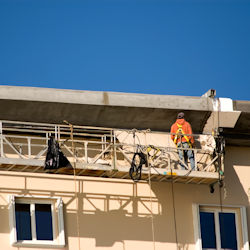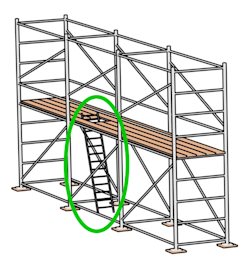Scaffold Safety
Suspended Scaffolds: Each rope on a suspended scaffold must support the scaffold's weight and at least six times the intended load.
The following is also required:
- Platforms must be at least 18 inches wide, (there are some exceptions), and guardrails and/or personal fall arrest systems must be used for fall protection any time you are working 10 feet or more above ground level.
- Guardrails must be between 39 and 45 inches high, and midrails must be installed approximately halfway between the toprail and the platform surface.
- Counterweights for suspended scaffolds must be able to resist at least four times the tipping moment (calculated by a qualified person). They must also be made of materials that cannot be easily dislocated (no sand, no water, no rolls of roofing, etc.).
Fall Protection: Fall protection is required when working on a scaffold 10 or more feet above the ground.
OSHA requires the following:
- The use of a guardrail OR a personal fall arrest system when working on a supported scaffold.
- Both a guardrail and a personal fall arrest system when working on a single-point or two-point suspended scaffold.
- A personal fall arrest system when working on an aerial lift.
Lifelines: The lifeline must be tied back to a structural anchorage capable of withstanding 5,000 lbs of dead weight per person tied off to it. Attaching your lifeline to a guardrail, a standpipe or other piping systems will not meet the 5,000 lbs. requirement and is not a safe move.
Protection from falling objects: Toe boards, screens, and debris nets must be in place to protect other people from falling objects.
Climbing on cross braces is not allowed! Ladders, stair towers, ramps, and walkways are some of the ways of providing safe access.
SOURCE: Adapted from Construction Safety & Health Fall Hazards, Central New York COSH, 2007, OSHA grant product.
Knowledge Check Choose the best answer for the question.
2-2. Lifelines must be able to support _____.
You forgot to answer the question!


